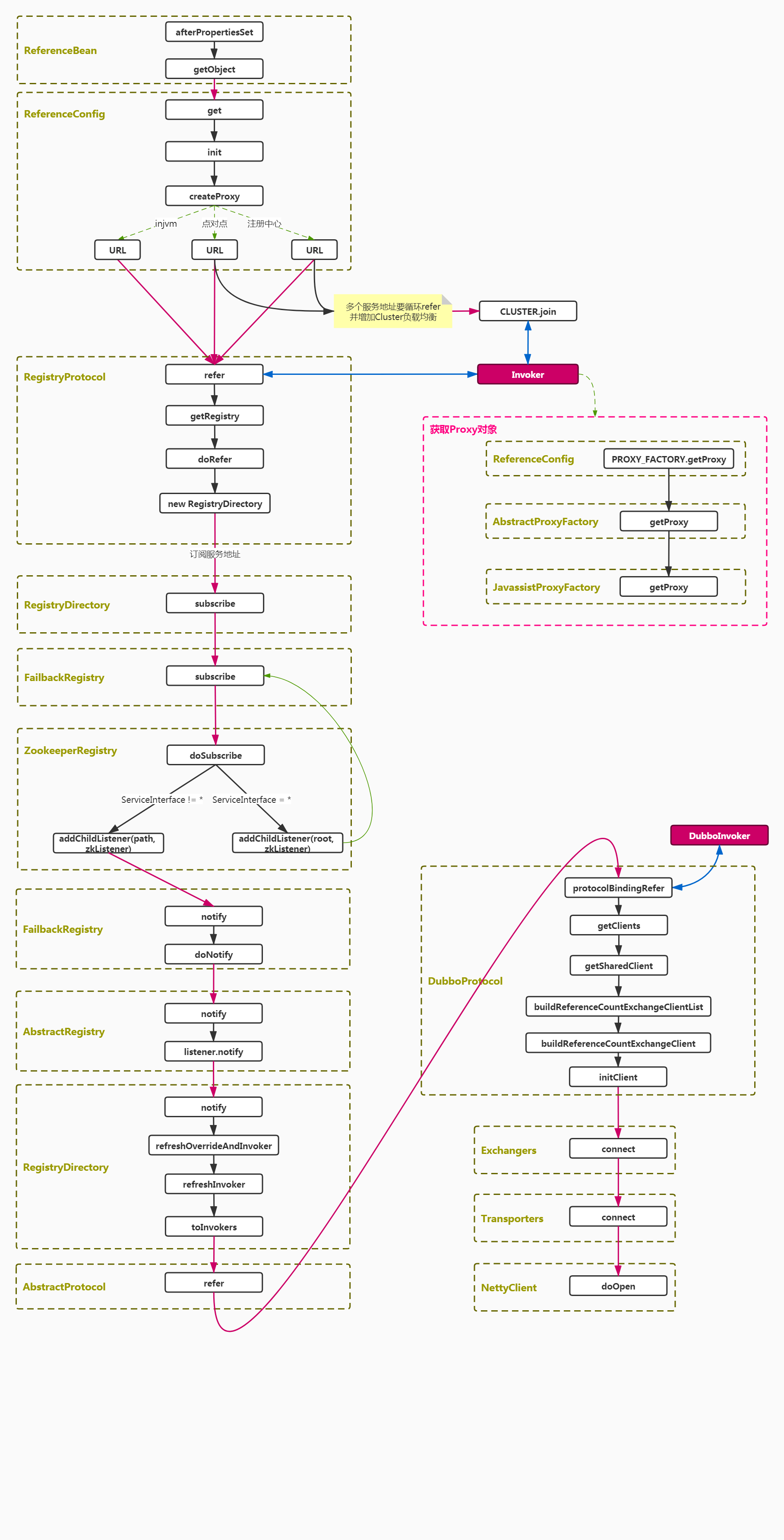Dubbo消费端Reference过程(Version2.7.3)
前言
前面Dubbo服务暴露完成了两个任务:1. 启动本地服务器。2. 将服务注册到注册中心。
服务暴露开始于ServiceBean,那么与之对应的,服务引用开始于ReferenceBean。
入口
入口有两个,都在ReferenceBean中
// 懒汉式(在 ReferenceBean 对应的服务被注入到其他类中时) public Object getObject() { return get(); } public void afterPropertiesSet() throws Exception { // 省略无关代码 // 饿汉式(在 Spring 容器调用 ReferenceBean 的 afterPropertiesSet 方法时) if (shouldInit()) { getObject(); } }
默认不会走afterPropertiesSet方法里的getObject方法,在启动容器注入依赖的时候,会走ReferenceBean的父类ReferenceConfig#get方法
public synchronized T get() { checkAndUpdateSubConfigs(); if (destroyed) { throw new IllegalStateException("The invoker of ReferenceConfig(" + url + ") has already destroyed!"); } if (ref == null) { init(); } return ref; }
调试开始
init方法(从这里开始,Apache的实现和alibaba的实现就完全不一样了,但是大体思路还是一样的)
// org.apache.dubbo.config.ReferenceConfig#init private void init() { // 已经初始化就返回 if (initialized) { return; } // 检查local或者stub 本地存根 是否有配置一个当前接口类型参数的构造函数 checkStubAndLocal(interfaceClass); // 检查mock配置 checkMock(interfaceClass); Map<String, String> map = new HashMap<String, String>(); map.put(SIDE_KEY, CONSUMER_SIDE); appendRuntimeParameters(map); // 不是泛型 if (!isGeneric()) { // 获取接口版本:1.0 String revision = Version.getVersion(interfaceClass, version); if (revision != null && revision.length() > 0) { map.put(REVISION_KEY, revision); } // 获取接口方法列表:{"hello"} String[] methods = Wrapper.getWrapper(interfaceClass).getMethodNames(); if (methods.length == 0) { logger.warn("No method found in service interface " + interfaceClass.getName()); map.put(METHODS_KEY, ANY_VALUE); } else { map.put(METHODS_KEY, StringUtils.join(new HashSet<String>(Arrays.asList(methods)), COMMA_SEPARATOR)); } } map.put(INTERFACE_KEY, interfaceName); appendParameters(map, metrics); appendParameters(map, application); appendParameters(map, module); // remove 'default.' prefix for configs from ConsumerConfig // appendParameters(map, consumer, Constants.DEFAULT_KEY); appendParameters(map, consumer); appendParameters(map, this); Map<String, Object> attributes = null; // 查看有没有方法配置(config) if (CollectionUtils.isNotEmpty(methods)) { attributes = new HashMap<String, Object>(); for (MethodConfig methodConfig : methods) { appendParameters(map, methodConfig, methodConfig.getName()); String retryKey = methodConfig.getName() + ".retry"; if (map.containsKey(retryKey)) { String retryValue = map.remove(retryKey); if ("false".equals(retryValue)) { map.put(methodConfig.getName() + ".retries", "0"); } } attributes.put(methodConfig.getName(), convertMethodConfig2AyncInfo(methodConfig)); } } // 获取注册地址 String hostToRegistry = ConfigUtils.getSystemProperty(DUBBO_IP_TO_REGISTRY); if (StringUtils.isEmpty(hostToRegistry)) { // 本地地址作为注册地址 hostToRegistry = NetUtils.getLocalHost(); } else if (isInvalidLocalHost(hostToRegistry)) { throw new IllegalArgumentException("Specified invalid registry ip from property:" + DUBBO_IP_TO_REGISTRY + ", value:" + hostToRegistry); } map.put(REGISTER_IP_KEY, hostToRegistry); // *** 不仅仅是创建代理对象,还要创建Invoker,订阅服务,启动客户端等 ref = createProxy(map); String serviceKey = URL.buildKey(interfaceName, group, version); ApplicationModel.initConsumerModel(serviceKey, buildConsumerModel(serviceKey, attributes)); initialized = true; }
上面代码做了什么事情呢
1. 收集配置信息,比如注册地址、接口名称、接口方法、版本信息等
2. 执行createProxy方法
private T createProxy(Map<String, String> map) { // 是否从当前JVM中引用目标服务的实例(如果指定了injvm,则true;如果指定了url,则认为是远程调用,false;如果没有指定,但是目标服务是在相同的JVM中提供的,进行本地调用,true) if (shouldJvmRefer(map)) { // 生成本地引用 URL,协议为 injvm URL url = new URL(LOCAL_PROTOCOL, LOCALHOST_VALUE, 0, interfaceClass.getName()).addParameters(map); invoker = REF_PROTOCOL.refer(interfaceClass, url); if (logger.isInfoEnabled()) { logger.info("Using injvm service " + interfaceClass.getName()); } } else { // 引用重试初始化会把url添加到url集合里,最终导致内存溢出。 urls.clear(); // url 不为空,表明用户可能想进行点对点调用 if (url != null && url.length() > 0) { // 当需要配置多个 url 时,可用分号进行分割,这里会进行切分 String[] us = SEMICOLON_SPLIT_PATTERN.split(url); if (us != null && us.length > 0) { for (String u : us) { URL url = URL.valueOf(u); if (StringUtils.isEmpty(url.getPath())) { // 设置接口全限定名为 url 路径 url = url.setPath(interfaceName); } // 检测 url 协议是否为 registry,若是,表明用户想使用指定的注册中心 if (REGISTRY_PROTOCOL.equals(url.getProtocol())) { urls.add(url.addParameterAndEncoded(REFER_KEY, StringUtils.toQueryString(map))); } else { urls.add(ClusterUtils.mergeUrl(url, map)); } } } } else { // 从注册中心的配置中组装URL // 如果协议不是injvm if (!LOCAL_PROTOCOL.equalsIgnoreCase(getProtocol())){ // 检查注册中心 checkRegistry(); // 加载注册中心 url List<URL> us = loadRegistries(false); if (CollectionUtils.isNotEmpty(us)) { for (URL u : us) { URL monitorUrl = loadMonitor(u); if (monitorUrl != null) { map.put(MONITOR_KEY, URL.encode(monitorUrl.toFullString())); } urls.add(u.addParameterAndEncoded(REFER_KEY, StringUtils.toQueryString(map))); } } if (urls.isEmpty()) { throw new IllegalStateException("No such any registry to reference " + interfaceName + " on the consumer " + NetUtils.getLocalHost() + " use dubbo version " + Version.getVersion() + ", please config <dubbo:registry address=\"...\" /> to your spring config."); } } } // 单个注册中心或服务提供者 if (urls.size() == 1) { // ***调用 RegistryProtocol 的 refer 构建 Invoker 实例 invoker = REF_PROTOCOL.refer(interfaceClass, urls.get(0)); } else { // 多个注册中心或多个服务提供者,或者两者混合 List<Invoker<?>> invokers = new ArrayList<Invoker<?>>(); URL registryURL = null; for (URL url : urls) { invokers.add(REF_PROTOCOL.refer(interfaceClass, url)); if (REGISTRY_PROTOCOL.equals(url.getProtocol())) { registryURL = url; // use last registry url } } if (registryURL != null) { // registry url is available // use RegistryAwareCluster only when register's CLUSTER is available URL u = registryURL.addParameter(CLUSTER_KEY, RegistryAwareCluster.NAME); // The invoker wrap relation would be: RegistryAwareClusterInvoker(StaticDirectory) -> FailoverClusterInvoker(RegistryDirectory, will execute route) -> Invoker invoker = CLUSTER.join(new StaticDirectory(u, invokers)); } else { // not a registry url, must be direct invoke. invoker = CLUSTER.join(new StaticDirectory(invokers)); } } } if (shouldCheck() && !invoker.isAvailable()) { throw new IllegalStateException("Failed to check the status of the service " + interfaceName + ". No provider available for the service " + (group == null ? "" : group + "/") + interfaceName + (version == null ? "" : ":" + version) + " from the url " + invoker.getUrl() + " to the consumer " + NetUtils.getLocalHost() + " use dubbo version " + Version.getVersion()); } if (logger.isInfoEnabled()) { logger.info("Refer dubbo service " + interfaceClass.getName() + " from url " + invoker.getUrl()); } /** * @since 2.7.0 * ServiceData Store */ MetadataReportService metadataReportService = null; if ((metadataReportService = getMetadataReportService()) != null) { URL consumerURL = new URL(CONSUMER_PROTOCOL, map.remove(REGISTER_IP_KEY), 0, map.get(INTERFACE_KEY), map); metadataReportService.publishConsumer(consumerURL); } // 最后创建服务代理对象 return (T) PROXY_FACTORY.getProxy(invoker); }
这么多,逻辑如下
1. 收集服务引用的配置信息,比如注册地址、接口名称、接口方法、版本信息等
2. 调用createProxy
- 首先根据配置检查是否为本地调用,若是,则调用 InjvmProtocol 的 refer 方法生成 InjvmInvoker 实例。
- 若不是,则读取直连配置项,或注册中心 url,并将读取到的 url 存储到 urls 中。
- 若 urls 元素数量为1,则直接通过 Protocol 自适应拓展类构建 Invoker 实例接口。
- 若 urls 元素数量大于1,即存在多个注册中心或服务直连 url,此时先根据 url 构建 Invoker。然后再通过 Cluster 合并多个 Invoker。
[重点]创建 Invoker
- Invoker 是由 Protocol 实现类 RegistryProtocol 构建而来。[重点]最后调用 ProxyFactory 生成代理类。
[重点]创建 Invoker
// org.apache.dubbo.registry.integration.RegistryProtocol#refer public <T> Invoker<T> refer(Class<T> type, URL url) throws RpcException { url = URLBuilder.from(url) // 给注册中心URL设置协议,比如:zookeeper .setProtocol(url.getParameter(REGISTRY_KEY, DEFAULT_REGISTRY)) .removeParameter(REGISTRY_KEY) .build(); // 获取注册中心实例 Registry registry = registryFactory.getRegistry(url); if (RegistryService.class.equals(type)) { return proxyFactory.getInvoker((T) registry, type, url); } // 根据url解析查询参数,比如:"register.ip" -> "10.204.241.39" "interface" -> "com.demo.common.HelloService" 键值对 Map<String, String> qs = StringUtils.parseQueryString(url.getParameterAndDecoded(REFER_KEY)); // 获取"group"对应的值,未设置为null String group = qs.get(GROUP_KEY); if (group != null && group.length() > 0) { if ((COMMA_SPLIT_PATTERN.split(group)).length > 1 || "*".equals(group)) { return doRefer(getMergeableCluster(), registry, type, url); } } // 执行doRefer方法(这种方法风格和Spring一样,比如Spring里getBean调用doGetBean等) return doRefer(cluster, registry, type, url); } private <T> Invoker<T> doRefer(Cluster cluster, Registry registry, Class<T> type, URL url) { // 注册中心URL:zookeeper://127.0.0.1:2181/org.apache.dubbo.registry.RegistryService?application=dubbo-consumer&client=curator&dubbo=2.0.2&interface=org.apache.dubbo.registry.RegistryService&pid=108324&qos.enable=false&release=2.7.3&timeout=5000×tamp=1584672980993 // RegistryDirectory对象,基于注册中心动态感知服务提供者的变化 RegistryDirectory<T> directory = new RegistryDirectory<T>(type, url); directory.setRegistry(registry); directory.setProtocol(protocol); // 获取URL查询参数键值对 Map<String, String> parameters = new HashMap<String, String>(directory.getUrl().getParameters()); // 组装订阅URL // consumer://10.204.241.39/com.demo.common.HelloService?application=dubbo-consumer&dubbo=2.0.2&interface=com.demo.common.HelloService&lazy=false&methods=hello&pid=108324&qos.enable=false&release=2.7.3&revision=1.0&side=consumer&sticky=false×tamp=1584672980764&version=1.0 URL subscribeUrl = new URL(CONSUMER_PROTOCOL, parameters.remove(REGISTER_IP_KEY), 0, type.getName(), parameters); if (!ANY_VALUE.equals(url.getServiceInterface()) && url.getParameter(REGISTER_KEY, true)) { directory.setRegisteredConsumerUrl(getRegisteredConsumerUrl(subscribeUrl, url)); registry.register(directory.getRegisteredConsumerUrl()); } directory.buildRouterChain(subscribeUrl); // 执行订阅逻辑 directory.subscribe(subscribeUrl.addParameter(CATEGORY_KEY, PROVIDERS_CATEGORY + "," + CONFIGURATORS_CATEGORY + "," + ROUTERS_CATEGORY)); // 创建Invoker并返回 Invoker invoker = cluster.join(directory); ProviderConsumerRegTable.registerConsumer(invoker, url, subscribeUrl, directory); return invoker; }
上面完成了
1. refer方法主要完成:根据注册中心URL获取注册中心实例。
2. doRefer方法:
- 获取RegistryDirectory对象,基于注册中心动态感知服务提供者的变化。
* 执行subscribe方法。
* 创建Invoker并返回
执行subscribe方法
// org.apache.dubbo.registry.integration.RegistryDirectory#subscribe public void subscribe(URL url) { // 设置消费者URL setConsumerUrl(url); CONSUMER_CONFIGURATION_LISTENER.addNotifyListener(this); serviceConfigurationListener = new ReferenceConfigurationListener(this, url); // 这里的registry是doRefer中设置的,所以这里执行的是注册中心的subscribe方法 registry.subscribe(url, this); } // org.apache.dubbo.registry.support.FailbackRegistry#subscribe // Failback:出故障时自动恢复 public void subscribe(URL url, NotifyListener listener) { super.subscribe(url, listener); removeFailedSubscribed(url, listener); try { // 向服务端发送一个订阅请求 doSubscribe(url, listener); } catch (Exception e) { Throwable t = e; List<URL> urls = getCacheUrls(url); if (CollectionUtils.isNotEmpty(urls)) { notify(url, listener, urls); logger.error("Failed to subscribe " + url + ", Using cached list: " + urls + " from cache file: " + getUrl().getParameter(FILE_KEY, System.getProperty("user.home") + "/dubbo-registry-" + url.getHost() + ".cache") + ", cause: " + t.getMessage(), t); } else { // If the startup detection is opened, the Exception is thrown directly. boolean check = getUrl().getParameter(Constants.CHECK_KEY, true) && url.getParameter(Constants.CHECK_KEY, true); boolean skipFailback = t instanceof SkipFailbackWrapperException; if (check || skipFailback) { if (skipFailback) { t = t.getCause(); } throw new IllegalStateException("Failed to subscribe " + url + ", cause: " + t.getMessage(), t); } else { logger.error("Failed to subscribe " + url + ", waiting for retry, cause: " + t.getMessage(), t); } } // Record a failed registration request to a failed list, retry regularly addFailedSubscribed(url, listener); } }
上面仅仅是做了一些属性设置,重点在于doSubscribe方法
ZookeeperRegistry
// org.apache.dubbo.registry.zookeeper.ZookeeperRegistry#doSubscribe public void doSubscribe(final URL url, final NotifyListener listener) { try { // 处理所有Service层发起的订阅,例如监控中心的订阅 if (ANY_VALUE.equals(url.getServiceInterface())) { // 获得根目录 String root = toRootPath(); // 获得url对应的监听器集合 ConcurrentMap<NotifyListener, ChildListener> listeners = zkListeners.get(url); // 不存在就创建监听器集合 if (listeners == null) { zkListeners.putIfAbsent(url, new ConcurrentHashMap<>()); listeners = zkListeners.get(url); } // 获得节点监听器 ChildListener zkListener = listeners.get(listener); if (zkListener == null) { listeners.putIfAbsent(listener, (parentPath, currentChilds) -> { // 遍历现有的节点,如果现有的服务集合中没有该节点,则加入该节点,然后订阅该节点 for (String child : currentChilds) { child = URL.decode(child); if (!anyServices.contains(child)) { anyServices.add(child); subscribe(url.setPath(child).addParameters(INTERFACE_KEY, child, Constants.CHECK_KEY, String.valueOf(false)), listener); } } }); // 重新获取,为了保证一致性 zkListener = listeners.get(listener); } // 创建service节点 zkClient.create(root, false); // 向zookeeper的service节点发起订阅,获得Service接口全名数组 List<String> services = zkClient.addChildListener(root, zkListener); if (CollectionUtils.isNotEmpty(services)) { // 遍历Service接口全名数组 for (String service : services) { service = URL.decode(service); anyServices.add(service); // 发起该service层的订阅 subscribe(url.setPath(service).addParameters(INTERFACE_KEY, service, Constants.CHECK_KEY, String.valueOf(false)), listener); } } } else { // 处理指定 Service 层的发起订阅,例如服务消费者的订阅 List<URL> urls = new ArrayList<>(); for (String path : toCategoriesPath(url)) { // path的可能值: // 0 = "/dubbo/com.demo.common.HelloService/providers" // 1 = "/dubbo/com.demo.common.HelloService/configurators" // 2 = "/dubbo/com.demo.common.HelloService/routers" // 获得监听器集合 ConcurrentMap<NotifyListener, ChildListener> listeners = zkListeners.get(url); if (listeners == null) { zkListeners.putIfAbsent(url, new ConcurrentHashMap<>()); listeners = zkListeners.get(url); } // 获得节点监听器 ChildListener zkListener = listeners.get(listener); if (zkListener == null) { listeners.putIfAbsent(listener, (parentPath, currentChilds) -> ZookeeperRegistry.this.notify(url, listener, toUrlsWithEmpty(url, parentPath, currentChilds))); zkListener = listeners.get(listener); } // 创建type节点 zkClient.create(path, false); // 向zookeeper的type节点发起订阅 List<String> children = zkClient.addChildListener(path, zkListener); if (children != null) { urls.addAll(toUrlsWithEmpty(url, path, children)); } } // 通知数据变化 notify(url, listener, urls); } } catch (Throwable e) { throw new RpcException("Failed to subscribe " + url + " to zookeeper " + getUrl() + ", cause: " + e.getMessage(), e); } }
这里注意,是订阅逻辑的主要实现(设计模式为观察者模式)
FailbackRegistry
// org.apache.dubbo.registry.support.FailbackRegistry#notify protected void notify(URL url, NotifyListener listener, List<URL> urls) { if (url == null) { throw new IllegalArgumentException("notify url == null"); } if (listener == null) { throw new IllegalArgumentException("notify listener == null"); } try { // 执行doNotify doNotify(url, listener, urls); } catch (Exception t) { // Record a failed registration request to a failed list, retry regularly addFailedNotified(url, listener, urls); logger.error("Failed to notify for subscribe " + url + ", waiting for retry, cause: " + t.getMessage(), t); } } protected void doNotify(URL url, NotifyListener listener, List<URL> urls) { // 交给父类 super.notify(url, listener, urls); }
AbstractRegistry
// org.apache.dubbo.registry.support.AbstractRegistry#notify(URL, NotifyListener, List<URL>) protected void notify(URL url, NotifyListener listener, List<URL> urls) { if (url == null) { throw new IllegalArgumentException("notify url == null"); } if (listener == null) { throw new IllegalArgumentException("notify listener == null"); } if ((CollectionUtils.isEmpty(urls)) && !ANY_VALUE.equals(url.getServiceInterface())) { logger.warn("Ignore empty notify urls for subscribe url " + url); return; } if (logger.isInfoEnabled()) { logger.info("Notify urls for subscribe url " + url + ", urls: " + urls); } // 按照类别存储URL,比如:"providers" "routers" "configurators" 三种类型作为key,value是对应的URL列表 Map<String, List<URL>> result = new HashMap<>(); for (URL u : urls) { if (UrlUtils.isMatch(url, u)) { String category = u.getParameter(CATEGORY_KEY, DEFAULT_CATEGORY); List<URL> categoryList = result.computeIfAbsent(category, k -> new ArrayList<>()); categoryList.add(u); } } if (result.size() == 0) { return; } Map<String, List<URL>> categoryNotified = notified.computeIfAbsent(url, u -> new ConcurrentHashMap<>()); // 遍历分好类别的URL for (Map.Entry<String, List<URL>> entry : result.entrySet()) { String category = entry.getKey(); List<URL> categoryList = entry.getValue(); categoryNotified.put(category, categoryList); // 通知URL的变化(告诉观察者) listener.notify(categoryList); // We will update our cache file after each notification. // When our Registry has a subscribe failure due to network jitter, we can return at least the existing cache URL. saveProperties(url); } }
这里注意,是通知逻辑的主要实现(设计模式为观察者模式),下面进入notify方法
RegistryDirectory
// org.apache.dubbo.registry.integration.RegistryDirectory#notify public synchronized void notify(List<URL> urls) { // 先把URL分好类 Map<String, List<URL>> categoryUrls = urls.stream() .filter(Objects::nonNull) .filter(this::isValidCategory) .filter(this::isNotCompatibleFor26x) .collect(Collectors.groupingBy(url -> { if (UrlUtils.isConfigurator(url)) { return CONFIGURATORS_CATEGORY; } else if (UrlUtils.isRoute(url)) { return ROUTERS_CATEGORY; } else if (UrlUtils.isProvider(url)) { return PROVIDERS_CATEGORY; } return ""; })); // 处理类型为configurators的URL List<URL> configuratorURLs = categoryUrls.getOrDefault(CONFIGURATORS_CATEGORY, Collections.emptyList()); this.configurators = Configurator.toConfigurators(configuratorURLs).orElse(this.configurators); // 处理类型的routers的URL List<URL> routerURLs = categoryUrls.getOrDefault(ROUTERS_CATEGORY, Collections.emptyList()); toRouters(routerURLs).ifPresent(this::addRouters); // 处理类型为providers的URL List<URL> providerURLs = categoryUrls.getOrDefault(PROVIDERS_CATEGORY, Collections.emptyList()); refreshOverrideAndInvoker(providerURLs); }
这里主要是收到URL的变化而响应的处理过程。我们知道Invoker 是 Dubbo 的核心模型,代表一个可执行体。那么我们检测到服务地址变化了,那么对应的Invoker肯定要一起改变。
在Debug过程遇到三种格式的URL:
empty://10.204.241.39/com.demo.common.HelloService?application=dubbo-consumer&category=routers&dubbo=2.0.2&interface=com.demo.common.HelloService&lazy=false&methods=hello&pid=10336&qos.enable=false&release=2.7.3&revision=1.0&side=consumer&sticky=false×tamp=1584948513183&version=1.0
empty://10.204.241.39/com.demo.common.HelloService?application=dubbo-consumer&category=configurators&dubbo=2.0.2&interface=com.demo.common.HelloService&lazy=false&methods=hello&pid=10336&qos.enable=false&release=2.7.3&revision=1.0&side=consumer&sticky=false×tamp=1584948513183&version=1.0
dubbo://10.204.241.14:20880/com.demo.common.HelloService?actives=5&anyhost=true&application=service-provider&bean.name=providers:dubbo:com.demo.common.HelloService:1.0&default.deprecated=false&default.dynamic=false&default.register=true&deprecated=false&dubbo=2.0.2&dynamic=false&generic=false&interface=com.demo.common.HelloService&methods=hello&pid=49328®ister=true&release=2.7.1&retries=3&revision=1.0&side=provider&timeout=3000×tamp=1563100343715&version=1.0
来看刷新Invoker方法
private void refreshOverrideAndInvoker(List<URL> urls) { // mock zookeeper://xxx?mock=return null overrideDirectoryUrl(); refreshInvoker(urls); } private void refreshInvoker(List<URL> invokerUrls) { Assert.notNull(invokerUrls, "invokerUrls should not be null"); // 如果地址只有一个并且协议参数值为empty,则禁止访问 if (invokerUrls.size() == 1 && invokerUrls.get(0) != null && EMPTY_PROTOCOL.equals(invokerUrls.get(0).getProtocol())) { this.forbidden = true; // Forbid to access this.invokers = Collections.emptyList(); routerChain.setInvokers(this.invokers); destroyAllInvokers(); // Close all invokers } else { this.forbidden = false; // Allow to access // 临时存储旧的UrlInvokerMap Map<String, Invoker<T>> oldUrlInvokerMap = this.urlInvokerMap; // local reference if (invokerUrls == Collections.<URL>emptyList()) { invokerUrls = new ArrayList<>(); } // 如果invokerUrls为空并且缓存不为空 if (invokerUrls.isEmpty() && this.cachedInvokerUrls != null) { invokerUrls.addAll(this.cachedInvokerUrls); } else { // 否则,添加到缓存 this.cachedInvokerUrls = new HashSet<>(); this.cachedInvokerUrls.addAll(invokerUrls);//Cached invoker urls, convenient for comparison } // 再次判断是否为空,为空则返回 if (invokerUrls.isEmpty()) { return; } // 能走到这里的地址格式: // dubbo://10.204.241.14:20880/com.demo.common.HelloService?... // 生成Map,key为url,value为Invoker Map<String, Invoker<T>> newUrlInvokerMap = toInvokers(invokerUrls);// Translate url list to Invoker map /** * If the calculation is wrong, it is not processed. * * 1. The protocol configured by the client is inconsistent with the protocol of the server. * eg: consumer protocol = dubbo, provider only has other protocol services(rest). * 2. The registration center is not robust and pushes illegal specification data. * */ if (CollectionUtils.isEmptyMap(newUrlInvokerMap)) { logger.error(new IllegalStateException("urls to invokers error .invokerUrls.size :" + invokerUrls.size() + ", invoker.size :0. urls :" + invokerUrls .toString())); return; } // 获取Invoker列表 List<Invoker<T>> newInvokers = Collections.unmodifiableList(new ArrayList<>(newUrlInvokerMap.values())); // pre-route and build cache, notice that route cache should build on original Invoker list. // toMergeMethodInvokerMap() will wrap some invokers having different groups, those wrapped invokers not should be routed. routerChain.setInvokers(newInvokers); this.invokers = multiGroup ? toMergeInvokerList(newInvokers) : newInvokers; this.urlInvokerMap = newUrlInvokerMap; try { // 销毁未使用的Invoker destroyUnusedInvokers(oldUrlInvokerMap, newUrlInvokerMap); // Close the unused Invoker } catch (Exception e) { logger.warn("destroyUnusedInvokers error. ", e); } } } private Map<String, Invoker<T>> toInvokers(List<URL> urls) { Map<String, Invoker<T>> newUrlInvokerMap = new HashMap<>(); if (urls == null || urls.isEmpty()) { return newUrlInvokerMap; } Set<String> keys = new HashSet<>(); String queryProtocols = this.queryMap.get(PROTOCOL_KEY); // 遍历URL for (URL providerUrl : urls) { // 如果在引用一端配置了protocol,只会匹配已选择的protocol if (queryProtocols != null && queryProtocols.length() > 0) { boolean accept = false; String[] acceptProtocols = queryProtocols.split(","); for (String acceptProtocol : acceptProtocols) { if (providerUrl.getProtocol().equals(acceptProtocol)) { accept = true; break; } } if (!accept) { continue; } } // 如果URL的protocol参数为empty,则跳过此次循环 if (EMPTY_PROTOCOL.equals(providerUrl.getProtocol())) { continue; } // 校验,是否有此协议的具体处理类 if (!ExtensionLoader.getExtensionLoader(Protocol.class).hasExtension(providerUrl.getProtocol())) { logger.error(new IllegalStateException("Unsupported protocol " + providerUrl.getProtocol() + " in notified url: " + providerUrl + " from registry " + getUrl().getAddress() + " to consumer " + NetUtils.getLocalHost() + ", supported protocol: " + ExtensionLoader.getExtensionLoader(Protocol.class).getSupportedExtensions())); continue; } // 合并URL,下面是合并前后的URL: // dubbo://10.204.241.14:20880/com.demo.common.HelloService?actives=5&anyhost=true&application=service-provider&bean.name=providers:dubbo:com.demo.common.HelloService:1.0&default.deprecated=false&default.dynamic=false&default.register=true&deprecated=false&dubbo=2.0.2&dynamic=false&generic=false&interface=com.demo.common.HelloService&methods=hello&pid=49328®ister=true&release=2.7.1&retries=3&revision=1.0&side=provider&timeout=3000×tamp=1563100343715&version=1.0 // dubbo://10.204.241.14:20880/com.demo.common.HelloService?actives=5&anyhost=true&application=dubbo-consumer&bean.name=providers:dubbo:com.demo.common.HelloService:1.0&check=false&default.deprecated=false&default.dynamic=false&default.register=true&deprecated=false&dubbo=2.0.2&dynamic=false&generic=false&interface=com.demo.common.HelloService&lazy=false&methods=hello&pid=110788&qos.enable=false®ister=true®ister.ip=10.204.241.39&release=2.7.1&remote.application=service-provider&retries=3&revision=1.0&side=consumer&sticky=false&timeout=3000×tamp=1563100343715&version=1.0 URL url = mergeUrl(providerUrl); // 把URL当做key String key = url.toFullString(); // The parameter urls are sorted if (keys.contains(key)) { // Repeated url continue; } // 缓存key keys.add(key); // Cache key is url that does not merge with consumer side parameters, regardless of how the consumer combines parameters, if the server url changes, then refer again Map<String, Invoker<T>> localUrlInvokerMap = this.urlInvokerMap; // local reference // 查看这个key是否有对应的Invoker Invoker<T> invoker = localUrlInvokerMap == null ? null : localUrlInvokerMap.get(key); // 缓存中没有对应的Invoker,则会创建 if (invoker == null) { try { boolean enabled = true; if (url.hasParameter(DISABLED_KEY)) { enabled = !url.getParameter(DISABLED_KEY, false); } else { enabled = url.getParameter(ENABLED_KEY, true); } if (enabled) { // 创建Invoker,来看refer方法 invoker = new InvokerDelegate<>(protocol.refer(serviceType, url), url, providerUrl); } } catch (Throwable t) { logger.error("Failed to refer invoker for interface:" + serviceType + ",url:(" + url + ")" + t.getMessage(), t); } if (invoker != null) { // Put new invoker in cache newUrlInvokerMap.put(key, invoker); } } else { // 缓存中有,放进新缓存中 newUrlInvokerMap.put(key, invoker); } } keys.clear(); return newUrlInvokerMap; }
这部分主要是关于刷新Invoker的:
1. 如果地址只有一个并且协议参数值为empty,则禁止访问。
2. 先查看缓存并保存副本,注意这个副本后面要用到。如果invokerUrls为空而缓存中不为空,则把缓存的值赋给invokerUrls;否则,把invokerUrls添加到缓存。
3. 把invokerUrls转换成key为url,value为Invoker的新Map集合。
- 遍历URL列表
- 对URL的protocol参数做校验
- 合并URL,并把URL的全称作为key
- 查看本地缓存有没有相应的key,没有则创建(调用AbstractProtocol#refer),并放入缓存
4. 把新生成的Map和之前保存的副本(旧Map)做对比,删除新Map中没有的元素(unused)。
AbstractProtocol
// org.apache.dubbo.rpc.protocol.AbstractProtocol#refer public <T> Invoker<T> refer(Class<T> type, URL url) throws RpcException { // 调用由子类实现的protocolBindingRefer方法 return new AsyncToSyncInvoker<>(protocolBindingRefer(type, url)); }
DubboProtocol
从RegistryProtocol到RegistryDirectory到DubboProtocol,绕了一大圈。
好不容易找到这里,仔细想来也合情合理:
1. 首先根据配置创建注册中心,然后 RegistryDirectory 执行服务订阅的逻辑;
2. 数据发生变化,肯定要随之更新影响的组件,执行 notify 逻辑,更新服务URl和Invoker;
3. Invoker又是由DubboProtocol创建的,就到了这里
// org.apache.dubbo.rpc.protocol.dubbo.DubboProtocol#protocolBindingRefer public <T> Invoker<T> protocolBindingRefer(Class<T> serviceType, URL url) throws RpcException { optimizeSerialization(url); // 1. 创建 rpc invoker // 2. 启动Netty客户端 DubboInvoker<T> invoker = new DubboInvoker<T>(serviceType, url, getClients(url), invokers); invokers.add(invoker); return invoker; }
来看getClients
private ExchangeClient[] getClients(URL url) { // whether to share connection boolean useShareConnect = false; // 如果没有配置,这里是0 int connections = url.getParameter(CONNECTIONS_KEY, 0); List<ReferenceCountExchangeClient> shareClients = null; // if not configured, connection is shared, otherwise, one connection for one service if (connections == 0) { // 没有配置connection,就选择共享的;否则一个服务一个connection useShareConnect = true; /** * The xml configuration should have a higher priority than properties. */ String shareConnectionsStr = url.getParameter(SHARE_CONNECTIONS_KEY, (String) null); connections = Integer.parseInt(StringUtils.isBlank(shareConnectionsStr) ? ConfigUtils.getProperty(SHARE_CONNECTIONS_KEY, DEFAULT_SHARE_CONNECTIONS) : shareConnectionsStr); shareClients = getSharedClient(url, connections); } // 根据前面计算得出的connections,创建ExchangeClient数组 ExchangeClient[] clients = new ExchangeClient[connections]; // 给数组分配值,如果使用共享的,则从共享客户端获取;否则新建 for (int i = 0; i < clients.length; i++) { if (useShareConnect) { clients[i] = shareClients.get(i); } else { clients[i] = initClient(url); } } return clients; } private List<ReferenceCountExchangeClient> getSharedClient(URL url, int connectNum) { // 地址作为key:10.204.241.14:20880 String key = url.getAddress(); // 先从缓存获取 List<ReferenceCountExchangeClient> clients = referenceClientMap.get(key); // 如果缓存中的客户端可用,则返回 if (checkClientCanUse(clients)) { batchClientRefIncr(clients); return clients; } locks.putIfAbsent(key, new Object()); synchronized (locks.get(key)) { // 再获取一遍,排除已创建的情况 clients = referenceClientMap.get(key); // dubbo check // 这里我觉得作者应该想写成 double check(双重检查) if (checkClientCanUse(clients)) { batchClientRefIncr(clients); return clients; } // connectNum 必须大于等于1 connectNum = Math.max(connectNum, 1); // clients为空,先初始化 if (CollectionUtils.isEmpty(clients)) { // *** 创建客户端 clients = buildReferenceCountExchangeClientList(url, connectNum); // 放入缓存 referenceClientMap.put(key, clients); } else { for (int i = 0; i < clients.size(); i++) { ReferenceCountExchangeClient referenceCountExchangeClient = clients.get(i); // If there is a client in the list that is no longer available, create a new one to replace him. if (referenceCountExchangeClient == null || referenceCountExchangeClient.isClosed()) { clients.set(i, buildReferenceCountExchangeClient(url)); continue; } referenceCountExchangeClient.incrementAndGetCount(); } } /** * I understand that the purpose of the remove operation here is to avoid the expired url key * always occupying this memory space. */ locks.remove(key); return clients; } } private List<ReferenceCountExchangeClient> buildReferenceCountExchangeClientList(URL url, int connectNum) { List<ReferenceCountExchangeClient> clients = new ArrayList<>(); // 根据connectNum决定初始化多少个客户端 for (int i = 0; i < connectNum; i++) { clients.add(buildReferenceCountExchangeClient(url)); } return clients; } // 包装一个ReferenceCountExchangeClient private ReferenceCountExchangeClient buildReferenceCountExchangeClient(URL url) { // 初始化 ExchangeClient exchangeClient = initClient(url); return new ReferenceCountExchangeClient(exchangeClient); } private ExchangeClient initClient(URL url) { // 获取客户端类型,比如:netty String str = url.getParameter(CLIENT_KEY, url.getParameter(SERVER_KEY, DEFAULT_REMOTING_CLIENT)); url = url.addParameter(CODEC_KEY, DubboCodec.NAME); // 默认开启心跳检测 url = url.addParameterIfAbsent(HEARTBEAT_KEY, String.valueOf(DEFAULT_HEARTBEAT)); // 如果没有str表示类型的Transporter具体实现类,抛出异常 if (str != null && str.length() > 0 && !ExtensionLoader.getExtensionLoader(Transporter.class).hasExtension(str)) { throw new RpcException("Unsupported client type: " + str + "," + " supported client type is " + StringUtils.join(ExtensionLoader.getExtensionLoader(Transporter.class).getSupportedExtensions(), " ")); } ExchangeClient client; try { // 判断是否懒加载 if (url.getParameter(LAZY_CONNECT_KEY, false)) { client = new LazyConnectExchangeClient(url, requestHandler); } else { // 非懒加载,立即初始化 client = Exchangers.connect(url, requestHandler); } } catch (RemotingException e) { throw new RpcException("Fail to create remoting client for service(" + url + "): " + e.getMessage(), e); } return client; }
这么多,做了什么事呢
1. 判断是否共享连接。没有配置connections属性则获取共享客户端,否则初始化新的客户端。【实际上如果共享客户端没有初始化,也会执行初始化的逻辑。】
2. 从URl中获取 IP:端口,作为key。先从缓存中获取引用客户端(ReferenceCountExchangeClient),缓存中没有则新建。
3. 根据connectNum决定初始化多少个客户端,执行初始化代码。
4. 先获取客户端类型,并校验是否存在此类型的处理类;然后判断是否配置为懒加载,否则把初始化任务交给Exchange层的connect方法。
Exchangers
// org.apache.dubbo.remoting.exchange.Exchangers#connect(URL, ExchangeHandler) public static ExchangeClient connect(URL url, ExchangeHandler handler) throws RemotingException { if (url == null) { throw new IllegalArgumentException("url == null"); } if (handler == null) { throw new IllegalArgumentException("handler == null"); } url = url.addParameterIfAbsent(Constants.CODEC_KEY, "exchange"); // 上面做了参数校验,然后通过Dubbo SPI获取具体的处理类,执行对应的connect方法 return getExchanger(url).connect(url, handler); } // org.apache.dubbo.remoting.exchange.support.header.HeaderExchanger#connect public ExchangeClient connect(URL url, ExchangeHandler handler) throws RemotingException { // 把处理交给Transport层,并将结果封装为HeaderExchangeClient return new HeaderExchangeClient(Transporters.connect(url, new DecodeHandler(new HeaderExchangeHandler(handler))), true); }
Dubbo把这一次定义为【exchange 信息交换层】,作用是封装请求响应模式,同步转异步。
Transporters
// org.apache.dubbo.remoting.Transporters#connect(URL, ChannelHandler...) public static Client connect(URL url, ChannelHandler... handlers) throws RemotingException { if (url == null) { throw new IllegalArgumentException("url == null"); } // 初始化ChannelHandler ChannelHandler handler; if (handlers == null || handlers.length == 0) { handler = new ChannelHandlerAdapter(); } else if (handlers.length == 1) { handler = handlers[0]; } else { handler = new ChannelHandlerDispatcher(handlers); } // 根据Dubbo SPI获取具体的处理类,并执行connect方法 return getTransporter().connect(url, handler); } // org.apache.dubbo.remoting.transport.netty4.NettyTransporter#connect public Client connect(URL url, ChannelHandler listener) throws RemotingException { // new一个Netty客户端 return new NettyClient(url, listener); }
Dubbo把这一层定义为【transport 网络传输层】,作用是抽象 mina 和 netty 为统一接口。
NettyClient
// org.apache.dubbo.remoting.transport.netty4.NettyClient public NettyClient(final URL url, final ChannelHandler handler) throws RemotingException { // you can customize name and type of client thread pool by THREAD_NAME_KEY and THREADPOOL_KEY in CommonConstants. // the handler will be warped: MultiMessageHandler->HeartbeatHandler->handler super(url, wrapChannelHandler(url, handler)); } // 这里面的 doOpen 和 connect 体现的是模板方法模式,调用过程由抽象类指定,方法由子类实现 public AbstractClient(URL url, ChannelHandler handler) throws RemotingException { super(url, handler); needReconnect = url.getParameter(Constants.SEND_RECONNECT_KEY, false); try { // 开启客户端 doOpen(); } catch (Throwable t) { close(); throw new RemotingException(url.toInetSocketAddress(), null, "Failed to start " + getClass().getSimpleName() + " " + NetUtils.getLocalAddress() + " connect to the server " + getRemoteAddress() + ", cause: " + t.getMessage(), t); } try { // 连接 connect(); if (logger.isInfoEnabled()) { logger.info("Start " + getClass().getSimpleName() + " " + NetUtils.getLocalAddress() + " connect to the server " + getRemoteAddress()); } } catch (RemotingException t) { if (url.getParameter(Constants.CHECK_KEY, true)) { close(); throw t; } else { logger.warn("Failed to start " + getClass().getSimpleName() + " " + NetUtils.getLocalAddress() + " connect to the server " + getRemoteAddress() + " (check == false, ignore and retry later!), cause: " + t.getMessage(), t); } } catch (Throwable t) { close(); throw new RemotingException(url.toInetSocketAddress(), null, "Failed to start " + getClass().getSimpleName() + " " + NetUtils.getLocalAddress() + " connect to the server " + getRemoteAddress() + ", cause: " + t.getMessage(), t); } executor = (ExecutorService) ExtensionLoader.getExtensionLoader(DataStore.class) .getDefaultExtension().get(CONSUMER_SIDE, Integer.toString(url.getPort())); ExtensionLoader.getExtensionLoader(DataStore.class) .getDefaultExtension().remove(CONSUMER_SIDE, Integer.toString(url.getPort())); } // org.apache.dubbo.remoting.transport.netty4.NettyClient#doOpen protected void doOpen() throws Throwable { final NettyClientHandler nettyClientHandler = new NettyClientHandler(getUrl(), this); bootstrap = new Bootstrap(); bootstrap.group(nioEventLoopGroup) .option(ChannelOption.SO_KEEPALIVE, true) .option(ChannelOption.TCP_NODELAY, true) .option(ChannelOption.ALLOCATOR, PooledByteBufAllocator.DEFAULT) //.option(ChannelOption.CONNECT_TIMEOUT_MILLIS, getTimeout()) .channel(NioSocketChannel.class); if (getConnectTimeout() < 3000) { bootstrap.option(ChannelOption.CONNECT_TIMEOUT_MILLIS, 3000); } else { bootstrap.option(ChannelOption.CONNECT_TIMEOUT_MILLIS, getConnectTimeout()); } bootstrap.handler(new ChannelInitializer() { @Override protected void initChannel(Channel ch) throws Exception { int heartbeatInterval = UrlUtils.getHeartbeat(getUrl()); NettyCodecAdapter adapter = new NettyCodecAdapter(getCodec(), getUrl(), NettyClient.this); ch.pipeline()//.addLast("logging",new LoggingHandler(LogLevel.INFO))//for debug .addLast("decoder", adapter.getDecoder()) .addLast("encoder", adapter.getEncoder()) .addLast("client-idle-handler", new IdleStateHandler(heartbeatInterval, 0, 0, MILLISECONDS)) .addLast("handler", nettyClientHandler); String socksProxyHost = ConfigUtils.getProperty(SOCKS_PROXY_HOST); if(socksProxyHost != null) { int socksProxyPort = Integer.parseInt(ConfigUtils.getProperty(SOCKS_PROXY_PORT, DEFAULT_SOCKS_PROXY_PORT)); Socks5ProxyHandler socks5ProxyHandler = new Socks5ProxyHandler(new InetSocketAddress(socksProxyHost, socksProxyPort)); ch.pipeline().addFirst(socks5ProxyHandler); } } }); }
这部分就是和Netty客户端最接近的代码了,自行去熟悉Netty即可。
除了Netty构建客户端的过程之外,这部分值得学习的就是模板方法的实际应用了。
最后看下整体的调用过程
createProxy:396, ReferenceConfig refer:392, RegistryProtocol doRefer:411, RegistryProtocol subscribe:172, RegistryDirectory subscribe:295, FailbackRegistry doSubscribe:183, ZookeeperRegistry notify:360, FailbackRegistry doNotify:369, FailbackRegistry notify:418, AbstractRegistry notify:233, RegistryDirectory refreshOverrideAndInvoker:239, RegistryDirectory refreshInvoker:280, RegistryDirectory toInvokers:423, RegistryDirectory refer:91, AbstractProtocol protocolBindingRefer:407, DubboProtocol getClients:430, DubboProtocol getSharedClient:475, DubboProtocol buildReferenceCountExchangeClientList:550, DubboProtocol buildReferenceCountExchangeClient:563, DubboProtocol initClient:595, DubboProtocol connect:109, Exchangers connect:39, HeaderExchanger connect:75, Transporters connect:40, NettyTransporter <init>:80, NettyClient <init>:60, AbstractClient doOpen:91, NettyClient
这个大体上满足官方所阐述的《整体设计》层次
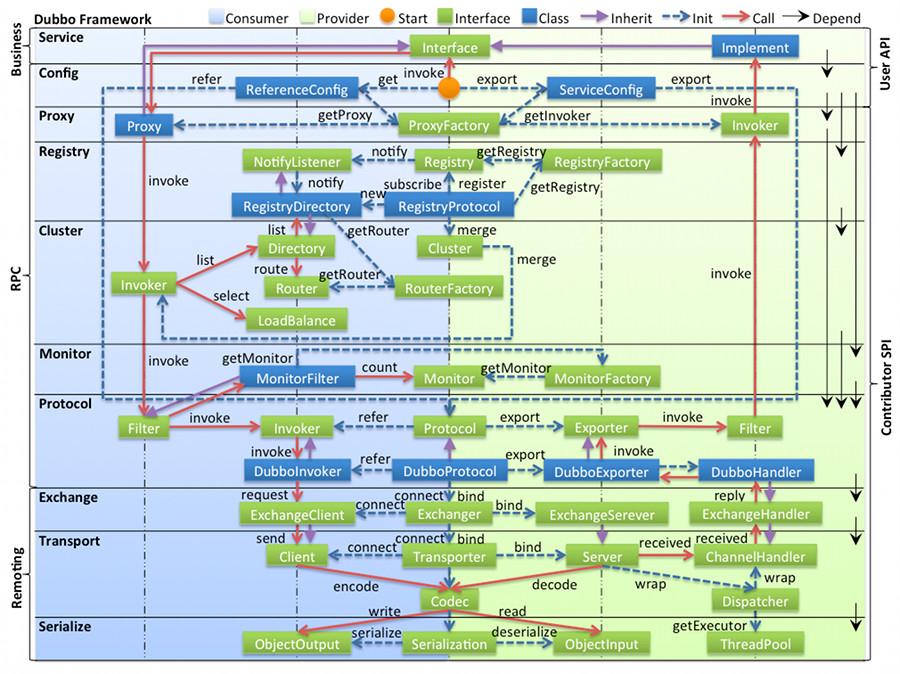
另附各层说明
- config 配置层:对外配置接口,以
ServiceConfig,ReferenceConfig为中心,可以直接初始化配置类,也可以通过 spring 解析配置生成配置类- proxy 服务代理层:服务接口透明代理,生成服务的客户端 Stub 和服务器端 Skeleton, 以
ServiceProxy为中心,扩展接口为ProxyFactory- registry 注册中心层:封装服务地址的注册与发现,以服务 URL 为中心,扩展接口为
RegistryFactory,Registry,RegistryService- cluster 路由层:封装多个提供者的路由及负载均衡,并桥接注册中心,以
Invoker为中心,扩展接口为Cluster,Directory,Router,LoadBalance- monitor 监控层:RPC 调用次数和调用时间监控,以
Statistics为中心,扩展接口为MonitorFactory,Monitor,MonitorService- protocol 远程调用层:封装 RPC 调用,以
Invocation,Result为中心,扩展接口为Protocol,Invoker,Exporter- exchange 信息交换层:封装请求响应模式,同步转异步,以
Request,Response为中心,扩展接口为Exchanger,ExchangeChannel,ExchangeClient,ExchangeServer- transport 网络传输层:抽象 mina 和 netty 为统一接口,以
Message为中心,扩展接口为Channel,Transporter,Client,Server,Codec- serialize 数据序列化层:可复用的一些工具,扩展接口为
Serialization,ObjectInput,ObjectOutput,ThreadPool
可以结合这个层次结构去熟悉源码

[重点]最后调用 ProxyFactory 生成代理类

进入的是抽象代理工厂
AbstractProxyFactory
// org.apache.dubbo.rpc.proxy.AbstractProxyFactory public <T> T getProxy(Invoker<T> invoker) throws RpcException { // 交给重载方法 return getProxy(invoker, false); } public <T> T getProxy(Invoker<T> invoker, boolean generic) throws RpcException { // interface com.demo.common.HelloService -> zookeeper://127.0.0.1:2181/org.apache.dubbo.registry.RegistryService?actives=5&anyhost=true&application=dubbo-consumer&bean.name=providers:dubbo:com.demo.common.HelloService:1.0&check=false&default.deprecated=false&default.dynamic=false&default.register=true&deprecated=false&dubbo=2.0.2&dynamic=false&generic=false&interface=com.demo.common.HelloService&lazy=false&methods=hello&pid=11484&qos.enable=false®ister=true®ister.ip=10.204.241.39&release=2.7.3&remote.application=service-provider&retries=3&revision=1.0&side=consumer&sticky=false&timeout=3000×tamp=1584952094835&version=1.0 Class<?>[] interfaces = null; // 获取interfaces参数值 String config = invoker.getUrl().getParameter(INTERFACES); // 如果有interfaces参数值 if (config != null && config.length() > 0) { // 拆分接口列表 String[] types = COMMA_SPLIT_PATTERN.split(config); if (types != null && types.length > 0) { interfaces = new Class<?>[types.length + 2]; interfaces[0] = invoker.getInterface(); interfaces[1] = EchoService.class; for (int i = 0; i < types.length; i++) { // 加载接口类 // 官网文档是不是有错误,是interfaces[i + 1]。如果这样的话,这里就会覆盖interfaces[1]的值了。 interfaces[i + 2] = ReflectUtils.forName(types[i]); } } } // 初始化interfaces if (interfaces == null) { // invoker.getInterface(): com.demo.common.HelloService interfaces = new Class<?>[]{invoker.getInterface(), EchoService.class}; } // 为 http 和 hessian 协议提供泛化调用支持 if (!GenericService.class.isAssignableFrom(invoker.getInterface()) && generic) { int len = interfaces.length; Class<?>[] temp = interfaces; interfaces = new Class<?>[len + 1]; System.arraycopy(temp, 0, interfaces, 0, len); interfaces[len] = com.alibaba.dubbo.rpc.service.GenericService.class; } // 进入JavassistProxyFactory类 return getProxy(invoker, interfaces); }
这一步主要利用Invoker创建interface的Class列表。
JavassistProxyFactory
public <T> T getProxy(Invoker<T> invoker, Class<?>[] interfaces) { // 1. Proxy.getProxy(interfaces),利用Javassist动态生成Proxy子类,其中实现了newInstance的细节。 // 2. 调用Proxy子类的newInstance方法生成服务接口代理类的一个实例 return (T) Proxy.getProxy(interfaces).newInstance(new InvokerInvocationHandler(invoker)); }
进入getProxy方法:
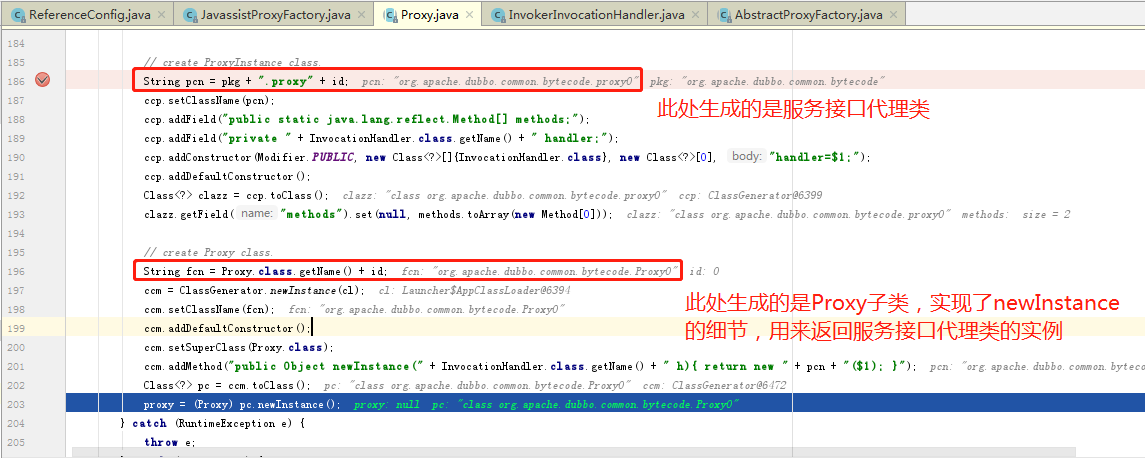
吐槽一下:这两个类的名字真骚啊,注意p的大小写
看一下生成的类大概是什么样子的。
利用阿里 Java 应用诊断工具 Arthas
1. 下载解压

2. 输入 java -jar arthas-boot.jar
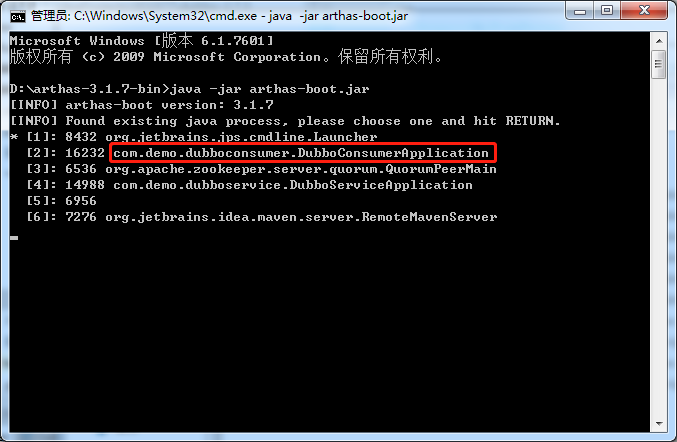
3. 上图红框的是我消费者应用,选择2
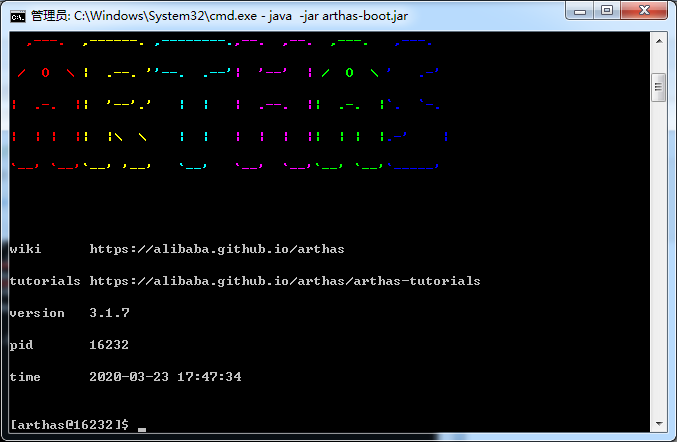
4. 输入 sc *.proxy0

5. 输入 jad org.apache.dubbo.common.bytecode.proxy0

完整代码
ClassLoader: +-sun.misc.Launcher$AppClassLoader@18b4aac2 +-sun.misc.Launcher$ExtClassLoader@4b53f538 Location: /E:/apache-maven-repo/org/apache/dubbo/dubbo/2.7.3/dubbo-2.7.3.jar /* * Decompiled with CFR. * * Could not load the following classes: * com.demo.common.HelloService */ package org.apache.dubbo.common.bytecode; import com.alibaba.dubbo.rpc.service.EchoService; import com.demo.common.HelloService; import java.lang.reflect.InvocationHandler; import java.lang.reflect.Method; import org.apache.dubbo.common.bytecode.ClassGenerator; public class proxy0 implements ClassGenerator.DC, HelloService, EchoService { public static Method[] methods; private InvocationHandler handler; public String hello() { Object[] arrobject = new Object[]{}; Object object = this.handler.invoke(this, methods[0], arrobject); return (String)object; } @Override public Object $echo(Object object) { Object[] arrobject = new Object[]{object}; Object object2 = this.handler.invoke(this, methods[1], arrobject); return object2; } public proxy0() { } public proxy0(InvocationHandler invocationHandler) { this.handler = invocationHandler; } }
再看一下Proxy子类的,输入 sc *.Proxy0

输入 jad org.apache.dubbo.common.bytecode.Proxy0
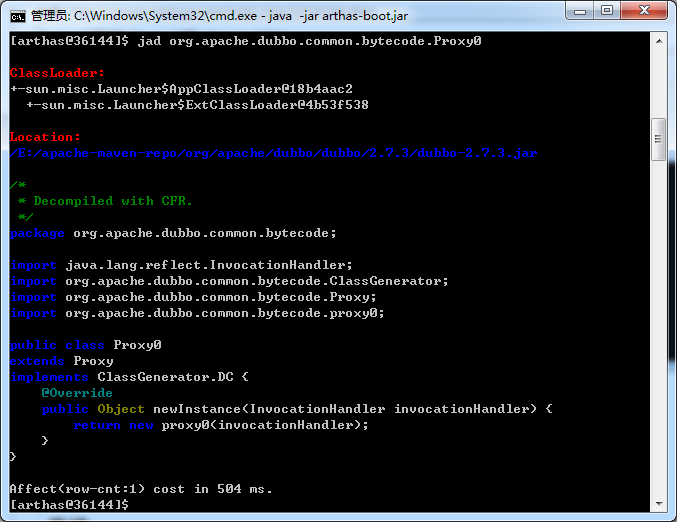
这个类里实现了Proxy抽象类定义的newInstance方法。
所以Proxy.getProxy方法一共生成了两个类的字节码,不是一个。
总结
注册中心细节:
服务提供者启动时: 向 /dubbo/com.demo.common.HelloService/providers 目录下写入自己的 URL 地址
服务消费者启动时: 订阅 /dubbo/com.demo.common.HelloService/providers 目录下的提供者 URL 地址。并向 /dubbo/com.demo.common.HelloService/consumers 目录下写入自己的 URL 地址。
读源码体会:
1. 要先去了解框架的层次,比如自上而下:config 配置层、proxy 服务代理层、registry 注册中心层、cluster 路由层、monitor 监控层、protocol 远程调用层、exchange 信息交换层、transport 网络传输层、serialize 数据序列化层。这些层次在源码中都有体现。
2. 要先大致清楚这个框架或者框架的某个功能解决了什么问题,你才能大致“猜到”某些源代码的目的。
3. 在代码细节方面学习的是代码习惯,在全局范围方面学习的是设计模式以及解决问题的思路,进而学习别人如何把系统变得健壮易扩展。
========================================2020-05-22更新:服务引用流程图
